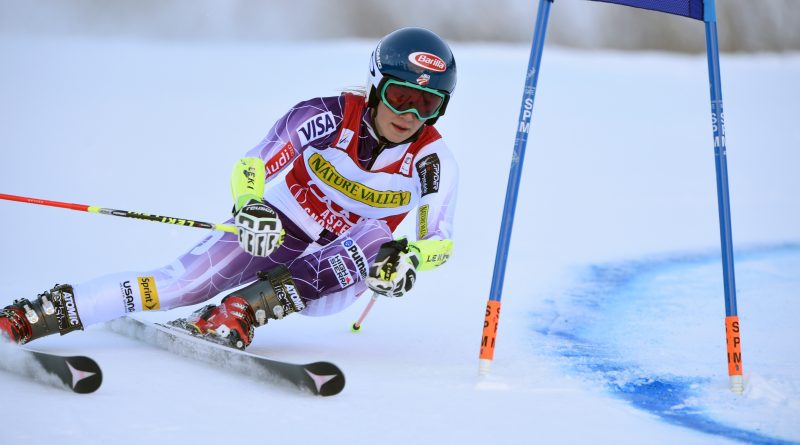The Woman to Watch
When the World Cup comes to Killington Nov. 25-26, all eyes are going to be on this recent Burke Mountain Academy grad.
Flash Forward
Tick. Tick. Tick. The digits on the clock flip by in hundreths of seconds as a racer punches through the gates on lower Superstar. At the Killington’s K2 base area, the crowds are clanging cowbells and cheering.
It is November 26, 2016. Higher up the mountain, Mikaela Shiffrin is in the starting gate, head and hands weaving imperceptibly as she visualizes her flight through the gates. Below, the course snakes down the Superstar trail before making its final, and steepest, plunge to the finish. Glassy smooth, the surface is hard as pavement.
A thousand vertical feet and some 40 to 60 gates below, a crowd has filled the grandstands, the Umbrella Bar, the K2 base lodge and every square foot of space in the base parking areas. As a racer skids to a finish, cheers go up in English, French, Italian and German. The parking area is a sea of people and tiny flags are waving. The boom of the announcer’s voice echoes off the mountainsides calling out the finish times.
Somewhere on the course are Shiffrin’s coaches: former Green Mountain Valley School coach Mike Day, who has worked with her since July, and her oldest coach, the woman who has trained her since she was born, her mother, Eileen.
Tick. Tick. Tick. The clock is running. At the base, the crowds grow silent, waiting for the world’s best slalom racer to break past the starting wand.
Shiffrin sees nothing but the first gate and the ribbon of red and blue poles laid out below. She takes a deep breath, compresses her body and then pushes off with such force the tails of her skis fly off the snow.
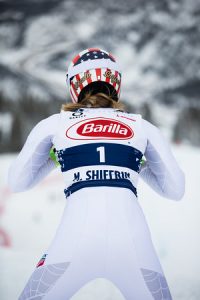
Mikaela Shiffrin has become one of the world’s most recognized athletes and, along with Lindsay Vonn, a major force in the power house of women who make up the United State’s World Cup ski team.
In 2016, Vonn, 31, became the winningest downhill skier of all time as she won her 20th World Cup crystal globe title, beating Ingemar Stenmark’s previous record. She is one of six women in history who has won World Cups in every discipline: downhill, super G, giant slalom, slalom and slalom combined. In terms of prize winnings, she led the World Cup in 2016, having earned 430,699 Swiss francs in winnings.
Right behind her in the prize money is Mikaela Shiffrin, the reigning Olympic and World Cup champion in slalom. Even though she was sidelined with a knee injury for part of last season, Shiffrin won all five slalom events she started, including one by a record 3.07 seconds. “That’s like a NASCAR driver winning by two laps,” says Tiger Shaw, president of the U.S. Ski and Snowboard Association, the sport’s governing body in the U.S.
After damaging her MCL on December 12, Shiffrin came back in mid-February, won her first event and finished the season with the third highest prize winnings of any woman on the World Cup.
Rounding out the team that’s likely to compete in the Killington slalom and giant slalom events on November 26-27 are veteran Julia Mancuso and Resi Stiegler. Mancuso has won four Olympic medals (in GS, downhill and combined) but was out all last season after hip surgery. Rising star Resi Stiegler, daughter of Olympic champion Pepi Stiegler, finished last season’s World Cup slalom category in 13th place overall.
At 21, Shiffrin is the youngest of the slalom/GS racers on the U.S. A Team and the only one who grew up skiing in New England. The Killington event, scheduled for Nov. 26-27, will be a homecoming for her, as it will for World Cup ski racing, which hasn’t had an East Coast stopover since 1991.
10,000 Hours of Race Training
It wasn’t that long ago—10 years, in fact—that Shiffrin was living in New Hampshire and skiing with her parents on tiny Storrs Hill, elevation 300 ft.
“I remember skiing at Killington with my parents when I was about nine, it was a pretty nasty day—cold and sleeting —and I specifically remember rushing into the gondola on my first ride up to get some shelter from the weather. I was thinking “Ugh, this is terrible, let’s just go home!” she recalls.
“But once I took my first run I completely forgot about the weather because I was having such a blast skiing,” she continues. “I remember feeling very proud of myself at the end of the day for sticking it out through the tough conditions. The waffle shack at the base of the mountain didn’t hurt either.”
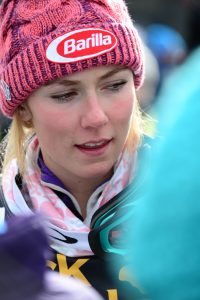
At the time, Eileen and Jeff Shiffrin—both former collegiate racers—had moved to New Hampshire from Vail so Jeff could take a job as an anesthesiologist with Dartmouth, his alma mater. Mikaela’s home training hill became Storrs Hill. She skied there five days a week.
“Mikaela would be out there from the minute the lifts ran until they closed,” remembers Tiger Shaw, a two-time Olympian who grew up in Stowe, went to Dartmouth and lived in Hanover, N.H. for 20 years. “The Shiffrins were skiing bell to bell— for them to ski the entire day wasn’t a blink of the eye. That’s what we are trying to teach kids around the country. You can’t get enough skiing and practice in,” he says.
“One of the reasons New England has turned out so many top racers is that we have maybe 30 ski mountains within a two- or three-hour drive,” Shaw continues. “Think of it: How do you get in 10,000 hours of practice time in? I tried to figure it out: I was 26 when I hit 10,000 hours. I bet Mikaela did that by the time she was 18.”
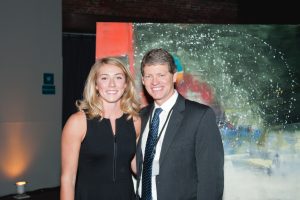
Shaw has known Shiffrin since she was born. “Her father helped deliver my daughter,” he says. Mikaela’s mother, Eileen would train for Masters ski racing with Shaw and his buddy, World Cup racer Felix McGrath, a former coach at University of Vermont. “Even at age seven Mikaela was beatingkids four years ahead of her. Just watching her ski, you knew she was something else.”
The summer she was nine, Shiffrin headed off to race camp at Mt. Hood. Her coach there, Simon Mars, once told Sports Illustrated, “she wrote down her ‘dream goal’ was ‘Be in the Olympics at 16.’”
Eileen Shiffrin took that goal seriously. She worked with both Mikaela and her son Taylor to train them to be better athletes, setting up gates in the backyard, watching soccer videos and teaching Mikaela to ride a unicycle.
“When I was a J5 I did a lot of freeskiing. I actually didn’t like freeskiing—I just thought it was a waste of time and I would’ve rather been training,” Shiffrin has said. “I always wanted to be thinking of something like ‘arms forward.’ My parents had a saying ‘knees to skis and hands in front’ and it’s been drilled into my head so that every time I get on snow that’s what I start thinking.”
At age 11, Mikaela followed her older brother, Taylor, to Burke Mountain Academy in Vermont’s Northeast Kingdom. Two years later, her family moved back to Vail. Mikaela went with them but missed her friends back East. So she came back to Burke. Her mother, Eileen, came with her and rented a condo nearby.
The first ski academy of its kind, Burke Mountain Academy has turned out 33 Olympians in the past 46 years. In 2015, eight grads—including Shiffrin, ‘13—were on the U.S. Alpine Ski Team and two on the Nordic team.
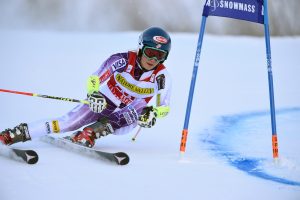
In 2010, at age 15, Mikaela put the world on notice by winning a NorAm Cup at Lake Louise. It was only the eighth time she’d ever competed at the international (FIS) level and she went on to podium at her next three NorAm races. A year later, at age 16, she became the youngest skier to ever win the U.S. Slalom Nationals and earned her first World Cup medal. In her second World Cup season, at age 17, she won the World Cup and the World Championship slalom titles. Then, in 2014, Shiffrin won the gold in the Sochi Olympics.
In other words, Shiffrin was spraying the crowds with Champagne long before she was legally old enough to drink.
The Best Coach for Mikaela is….
Looking at the results, it’s easy to forget Shiffrin turned 21 last May. But watch her videos and follow her on social media and you see another side of her.
Unlike the cool, collected Vonn—a woman who has lived under a glaring spotlight as she dated Tiger Woods and, this past year, posed for the Sports Illustrated swimsuit issue clad only in body paint— Shiffrin still carries the joy and innocence of a kid and is a self-confessed goofball.
In her video clips you see her and her teammates rocking out in their ski boots, doing car karaoke and lip syncing to Adele—until she cracks herself up.
“I listen to every kind of music,” she says. “Sia, Ellie Goulding, Adele, The Shins, Maroon 5, anything with a good beat and a good melody that can pump me up. I like the kind of music that makes you want to dance, because skiing is a lot like dancing to me.”
Watching “The World Cup Diaries,” a rough YouTube edit of footage her former coach Brandon Dyksterhouse filmed during the 2015-16 season, you see a joyful Shiffrin dancing on the podium, dancing on the mountain, dancing in the gondola. Her feet move with the same lightning precision as they do in the edge-to-edge, knife-like cuts that ricochet her through the slalom gates.
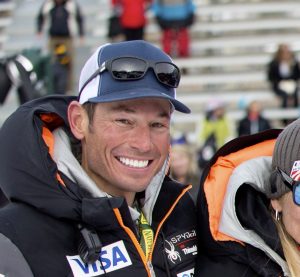
In January, 2015, Dyksterhouse—at the time a coach at Ski & Snowboard Club Vail, got the call asking if he would serve as “interim” coach, replacing Roland Pfeifffer to coach the Olympic medalist. Dysterhouse was an NCAA champ at the University of Vermont and a coach at his alma mater, Waitsfield’s Green Mountain Valley School. When he got the call he told The Denver Post, ‘Bleep, are you kidding me?’ When Michael Jordan calls, there’s no other answer, right?” It was a month before the World Championships. After Shiffrin won the Worlds, Dyksterhouse’s “interim” title was dropped.
While Shiffrin is notorious for looking to perfect every turn in the gates, Dyksterhouse wanted her out of the course. After the Worlds, they did a lot of freeskiing, some of it in terrain parks so Shiffrin would be more comfortable on a variety of surfaces. On the training hill, Dyksterhouse actually built terrain into courses so Shiffrin would get stronger absorbing knolls and jumps.
“It was awesome—three weeks of some of the most productive skiing I have had, at a time when most coaches and athletes are ready to drop off the map for some R&R,” Shiffrin told The Denver Post’s John Meyer.
Dyksterhouse likes to downplay his role. “Well, let’s put it this way, my first job with an athlete like Mikaela was not to make her worse. When I started that was always goal number one. Then comes her happiness and managing the fatigue that comes along with being on the road for an entire winter living out of bags.”
His videos document the four a.m. alarms, moving boatloads of skis through mountain towns and airports and the formidable behind-the-scenes logistics competitors face on the White Circus, as the World Cup is often called.
“It’s managing what seem like very small logistical details like: Where is the hotel exactly? Where do you park? Is there adequate space, security and accessibility? What is being offered at meals? If there is an early breakfast and will there be hot food available? Is there a quiet way to get around the hotel or do you need to go through the lobby all the time? Being on top of all these small things lessens the cumulative stress. It sounds kind of stupid but it adds a lot of value, especially to a high profile athlete like Mikaela.”
Helping him were assistant coach Jeff Lackie and the person who has always been Mikaela’s number one coach, her mother Eileen.
“When you see a top skier, it’s often traceable to one person–a coach or a parent,” says Shaw. “For Mikaela, there is no better coach in the world than Eileen.”
“Not everyone can dedicate their lives to their kid,” he continues. Ever since Mikaela began competing internationally, Eileen has been there beside her, paying her own way to travel with the team, working with her on the hill and always pushing both her daughter and her coaches for more.
This past July, Dyskterhouse surprised many by abruptly resigning from the U.S. Ski Team and returned to his old job at Vail. He still claims “Superfan” status and will no doubt be watching his former student as she races in Killington this November.
“There’s a passion and intensity for ski racing in Vermont and in the East that is unrivaled,” Dyksterhouse says. “East Coasters are just a little more intense and less patient, all in a good way. They have that diehard energy. I hopethere are 50,000 people there. The races will rejuvenate and reenergize the sport. Everyone I talk to about it is already so excited,” he says.

Shiffrin is too. “I’m excited to bring World Cup racing back to the East and hopefully spark even more interest in the sport,” she says. “I also love racing in front of a home crowd because I can really feel the support carrying me down the mountain.”
She continues: “New England ski fans are awesome. I mean, all ski fans are awesome really, but the East really tests your passion for the sport. It throws every weather and snow condition at you all at once, so if you see a fan in the East Coast, you know they are truly loyal to the sport.”
A Vermont Homecoming
For Shaw, it’s been a dream to bring the World Cup back to his home state. It’s been 25 years since the event was held on the East Coast and the last Vermont venue was Stratton, in 1978. Traditionally, Aspen has hosted the early season U.S. races but this year, it will host the World Cup finals in March, which opened up a spot for another early season site. Depending on how permitting goes for Aspen’s new base-area lifts, this may allow the World Cup to come back to Killington again if all goes well this November, says Shaw.
“There’s one man who decides where a World Cup will be,” says Shaw, “and that’s FIS Women’s World Cup Tour Director Atle Skaardal.”
Mike Solimano, president of Killington, remembers walking the Superstar course with Skaardal in September, 2015, as part of the site inspection. “He hadn’t skied it or even seen it with snow but he said ‘it’s perfect!,” Solimano says. Shaw agrees, “On a lot of courses you have to alter the terrain, this one won’t need that.”
On top of that, Shaw is excited about the proximity to so many urban areas and notes that Killington is one of the few World Cup sites where there’s actually a two-lane road that drives right up to the finish line. “This is possibly one of the best places in the world for being able to watch a huge portion of a World Cup race. It’s unbelievable,” he says.
When Killington put the $350 VIP grandstand seats with access to the Umbrella Bar on sale last July they sold out in under six hours. The resort is considering opening more. “But keep in mind that there’s still a lot of great spectator opportunities right at the base area,” says Killington marketing director Rob Megnin. “And that’s free. We really want as many people as possible to have a great view of the action.”
The resort has also planned for three major movie premieres from Teton Gravity Research, Warren Miller and Matchstick Productions. It’s also in the process of booking what Megnin promises to be “some major live music acts,” to perform. “It’s going to be one big party weekend,” he promised.
Another huge factor in hosting the World Cup has been Killington’s ability to lay down the six feet of base needed for a race like this,
“I am a bit worried that there won’t be enough snow,” Shiffrin admitted earlier in the summer. However, she added, “As long as it’s cold enough I have full confidence that Killington will pull off an awesome event—but you can never be sure that the temperatures will cooperate. We have had races canceled in the middle of the winter in Europe because of lack of snow.”
Solimano has no qualms: “We have one whole team that’s devoted to snowmaking just for the course, and another for the rest of the mountain,” he says. In fact, he’s hoping it won’t snow. “Removing snow from the course is actually harder than making it. If we can get a couple of days of sustained cold, that would be ideal. It would be way better if it was 40 percent humidity and 20 degrees than if it was 30 degrees and snowing.”
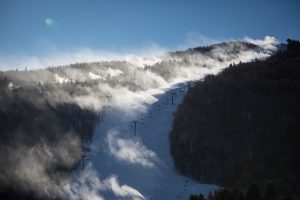
Says Dysksterhouse of the Killington course: “I think it’s going to be incredibly hard. It’s quite a sustained pitch and the weather is going to be a big factor. It could be very damp or frigid, so there are a lot of unknowns. Teams will need to have multiple plans in place for training leading up to the race. Of course, everyone will have a different budget and that will factor in to how athletes find snow that will be similar to the race conditions.”
Some teams may try to set up training at other nearby resorts but with the opening World Cup GS race in Soelden, Austria on October 22 and then a World Cup slalom in Levi, Finland on November 12, there will not be much time to acclimate to Vermont’s conditions.
For Shiffrin, who has been skiing damp, frigid New England courses since she was a kid, that could be an advantage. “In general, I think technically strong racers tend to prevail in the East, and Killington will be no different,” she says.
Late in August, Shiffrin was in New Zealand training with her new coach, Mike Day, who had previously coached two-time Olympic gold medalist Ted Ligety. Day left his role as coach at Green Mountain Valley School to join her there, working with her both on snow and on dryland training.
Shiffrin’s social media feeds (which often feature her saying, at some point, “now this is awkward”) show her flowing through the gates like water. They also show her weight lifting, doing squats and lunges, riding a pump track and even, in New Zealand, throwing boulders to build strength.
Perhaps most telling is a video short of her furiously pumping away at what looks like a Stairmaster machine. Her caption reads: “The first step to success is admitting the possibility of failure. Then do everything in your power to defeat that possibility.”
Interviews by Marina Knight.

